Highlights in Pisa
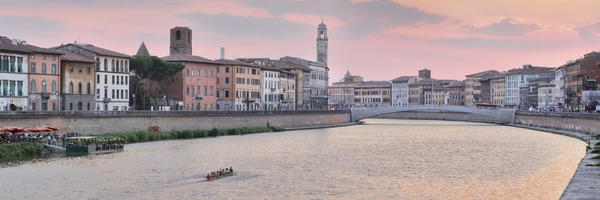
Standing in a large green expanse, the monumental complex of the Piazza del Duomo in Pisa is an extraordinary place, which has preserved over time the beauty and historical, artistic and landscape qualities of its heritage.
In this place, also known as ‘Piazza dei Miracoli’, the memory of the past is kept alive, so that it may be a source of inspiration for contemporaries and a cultural heritage for future generations.
It has recognized as a World Heritage Site by UNESCO in 1987.
The UNESCO World Heritage Center conferred the title of World Heritage Site of Piazza del Duomo in December 1987, on the occasion of the eleventh Conference of the World Heritage Committee.
The complex contains a series of medieval architectural works, including four world-famous masterpieces: the Cathedral, the Baptistery, the Bell Tower, and the Campo Santo.
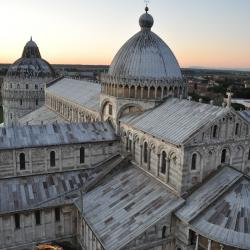 The Cathedral, dedicated to Santa Maria Assunta, or Duomo, represents an innovative Church model for the times, which influenced the architectural works in other Tuscan cities, such as Lucca and Pistoia – and also in the territories that were historically under the dominion of Maritime Republic of Pisa, such as Sardinia and Corsica. During the construction of the main building, were inserted, on the side’s walls, reused materials from Roman monuments to underline the greatness of Pisa as "another Rome".
The Cathedral, dedicated to Santa Maria Assunta, or Duomo, represents an innovative Church model for the times, which influenced the architectural works in other Tuscan cities, such as Lucca and Pistoia – and also in the territories that were historically under the dominion of Maritime Republic of Pisa, such as Sardinia and Corsica. During the construction of the main building, were inserted, on the side’s walls, reused materials from Roman monuments to underline the greatness of Pisa as "another Rome".
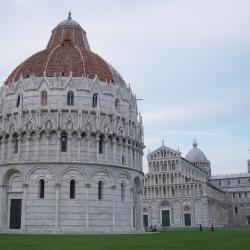 The Baptistery is an imposing structure, surrounded, like the Cathedral, by arches on columns. It has a roof system consisting of a double dome, an internal truncated cone, and an external hemispherical cap, which gives the environment exceptional acoustics which make it a real "musical instrument".
The Baptistery is an imposing structure, surrounded, like the Cathedral, by arches on columns. It has a roof system consisting of a double dome, an internal truncated cone, and an external hemispherical cap, which gives the environment exceptional acoustics which make it a real "musical instrument".
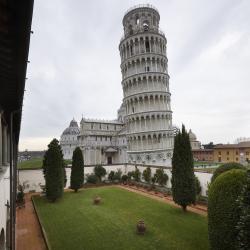 The Tower, or Bell Tower, with its seven huge bells and splendid architecture, is the Bell Tower of the Cathedral of Santa Maria Assunta, the symbol of Pisa and one of the most iconic symbols of Italy. It tilted shortly after its construction and became what, even today, is known throughout the world as the Leaning Tower of Pisa, tilted 3.9° with respect to its vertical axis. The structure consists of two concentric cylinders connected by an internal spiral staircase that ends at the access to the upper cell. Indeed, the prevailing features of the monument are the curved lines that develop in the blind arches and in the six floors of loggias present on the external cylinder and divided by columns on which round arches rest.
The Tower, or Bell Tower, with its seven huge bells and splendid architecture, is the Bell Tower of the Cathedral of Santa Maria Assunta, the symbol of Pisa and one of the most iconic symbols of Italy. It tilted shortly after its construction and became what, even today, is known throughout the world as the Leaning Tower of Pisa, tilted 3.9° with respect to its vertical axis. The structure consists of two concentric cylinders connected by an internal spiral staircase that ends at the access to the upper cell. Indeed, the prevailing features of the monument are the curved lines that develop in the blind arches and in the six floors of loggias present on the external cylinder and divided by columns on which round arches rest.
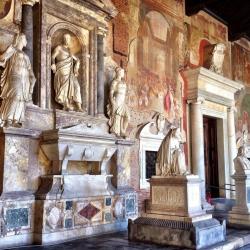 The Camposanto (or Camposanto Monumentale) is one of the oldest Christian buildings destined for the cult of the dead during the Middle Ages. During the fourteenth century, the interior walls came alive with wonderful frescoes, centered on the themes of Life and Death, which started a new phase of pictorial art: among which "The Triumph of Death"
The Camposanto (or Camposanto Monumentale) is one of the oldest Christian buildings destined for the cult of the dead during the Middle Ages. During the fourteenth century, the interior walls came alive with wonderful frescoes, centered on the themes of Life and Death, which started a new phase of pictorial art: among which "The Triumph of Death"
Lungarni: Many poets and artists have been fascinated by the Lungarni Pisani inspired b y the splendid noble palaces overlooking the Arno River. Today this location is also home to important museums overlooking the Arno, creating a true "museum system." This is a picturesque walk with the river as its theme, which has always been inextricably linked to the life of the city.
y the splendid noble palaces overlooking the Arno River. Today this location is also home to important museums overlooking the Arno, creating a true "museum system." This is a picturesque walk with the river as its theme, which has always been inextricably linked to the life of the city.
For a complete local guide please refer to the city official webiste: Pisa